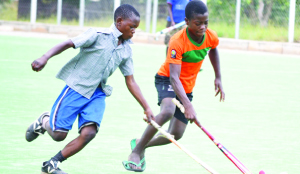
• SPORTS for all: Young aspiring stars showing off their hockey skills at the Olympic Youth Development Centre in Lusaka.
WE all take great pride in seeing young people from our community achieve success in sport, as is the case in all other areas of life.
However, the recent underperformance by Zambia’s football teams in African competitions has raised dust from all corners of society.
This development has led to a number of divergent views from stakeholders across the country, who feels changes should be made.
On one hand, stakeholders have suggested the course of action that should be taken to better matters; while on the other, the Football Association of Zambia (FAZ) has given its direction on what will abate the poor results.
But in all their arguments, it boils down to lack of increased investment in the grassroots, youth football to be precise as well as sports infrastructure.
Football is indisputably the most popular sport in Zambia even though there are other sports codes that have scored more success than it.
Various writers have tackled the recent slump on the football scene in so many versions but I was compelled to use football failures as a
model to highlight the importance of investing in the grassroots to safeguard future prospects.
It all started with the under-17 female team’s first round exit from the FIFA Women World Cup in Costa Rica last year, the women senior team followed suit at the Africa Women Championship in Namibia.
The Chipolopolo were also seen off in the group stage during the Equatorial Guinea 2015 Africa Cup of Nations just as the under-17 and
20 teams exited the Africa Junior and Youth Championships respectively while the under-23 squad failed to make it to the 2015 All Africa Games (AAG).
 What is happening to football today can happen to any other sport in the country and therefore, people should learn from this.
What is happening to football today can happen to any other sport in the country and therefore, people should learn from this.
We all wish well our sports men and women in their endeavors to shine at international competitions because as fans, we are emotionally attached to the sports and teams we rally behind.
What is it that Kenya has done to produce good quality athletes which Zambia is not doing? What has made neighboring Angola a powerhouse in Basketball I Africa? Why is Nigeria always on top of Zambia when it comes to football and yet we are in the same continent? The list of questions is endless.
As nation, there is need to reflect on the health of football and other sports at a national and grassroots level, and to consider the wider benefits that sports give to our communities.
Zambia is endowed with so much talent that the country can produce the likes of Lionel Messi, Kobe Bryant, Novak Djokovic and Floyd Mayweather Junior of this world only if there is huge investment in the grassroots.
Youths can take inspiration from other local sports men and women who have gone on to receive national and international honours, like Olympic bronze medalist late boxer Keith Mwila and world hurdles champion Samuel Matete among others.
To make sure that young people have the opportunity to reach their full potential in sport, the country needs to invest in the best possible facilities for them. Proper sports infrastructure is critical very to producing future champions.
There have been some remarkable improvements in the selected sports disciplines since the Olympic Youth Development Centre (OYDC) in Lusaka was opened to the public.
The facility that was put up with the help from the International Olympic Committee (IOC) under the Olympic solidarity initiative has given us some of the best facilities for hockey, netball, basketball, volleyball and swimming in the county.
As a result of this, there are now more young people playing in more teams from this facility, than before. The OYDC management has established an excellent coaching programme for boys and girls who aspire to be stars in various sports fields.
The programme is a “sport for all’ mentality that underpins grassroots sport. It focuses on encouraging sporting participation on a broader scale and facilitating the channels up to elite levels of performance. Kalusha Bwalya did not instantly emerge as a footballing genius.
He began from a collection of football pitches on the Copperbelt, synonymous with the grassroots and developed into one of the revered assets in the national team.
Investing in the grassroots is all about having a clear strategy in place to nurture talent from childhood up to the time an individual develops into a fully fledged player.
It is also all about increasing access to our national sports so that more people, whatever their background, can enjoy the benefits of playing it, and have an improved experience of playing it so they can represent the country competitively.
But it is certainly true that a very happy by-product of a healthy grassroots game is that it helps underpin the health of that sport at the elite level.
We cannot all be a future sports star, but there is no doubt that sports are a positive way of channeling the energies and interests of young people; that is greatly beneficial for them and for society.
Investment in grassroots sport is an investment in the future of the whole country.
I think the time has come to really build meaningful support for grassroots sports as more and more people are recognising the problems facing our national sport and becoming open to new ideas aimed at putting things right.
For Zambia to improve the level of international performance in football there is need to start from the bottom but we seem to be miles and miles away from where the MTN-FAZ super league stands and where the grassroots football is.
There is so much money from the corporate world that is committed to football but sadly, it is being concentrated at the top. It is time for the business community to put money where it matters most by extending an olive branch to the grassroots.
Every Zambian interested in seeing the long-term health of sports in the country, wants to see better grassroots facilities and higher levels of participation, particularly amongst young people.
There is also need to support projects that focus on improving sports coaching in schools and inspiring young people to engage in sport.
Once the dust settles on the dismal results just gone, we need to look forward to the forthcoming competitions with the hope that people will be full of the joy of success.
As promised in the last edition, here is what some readers reacted on the topic ‘The power of the Captain’s armband’… Mary Nyambe of Livingstone wrote, “I enjoyed reading your article on the impacts of captains on team play and since then I have been paying close attention to selection and performance of captains.
“On the basis of my experience, I believe the captain can have a significant impact on overall team performance because his influence on the team performance is so complex.
“Although this is not a testable proposition in the scientific sense, it is closer to an Economics or Psychology hypothesis and to me, your suggestion is right.”
Kashiba Chola wrote, “As an ex-footballer, I agree with you and indeed the captainship forces players to raise their game. I have observed that those players that experience disciplinary problems, giving them the armband makes them to improve their behavior on and off the pitch.”
Keep your comments coming: moseschimfwembe@gmail.com






